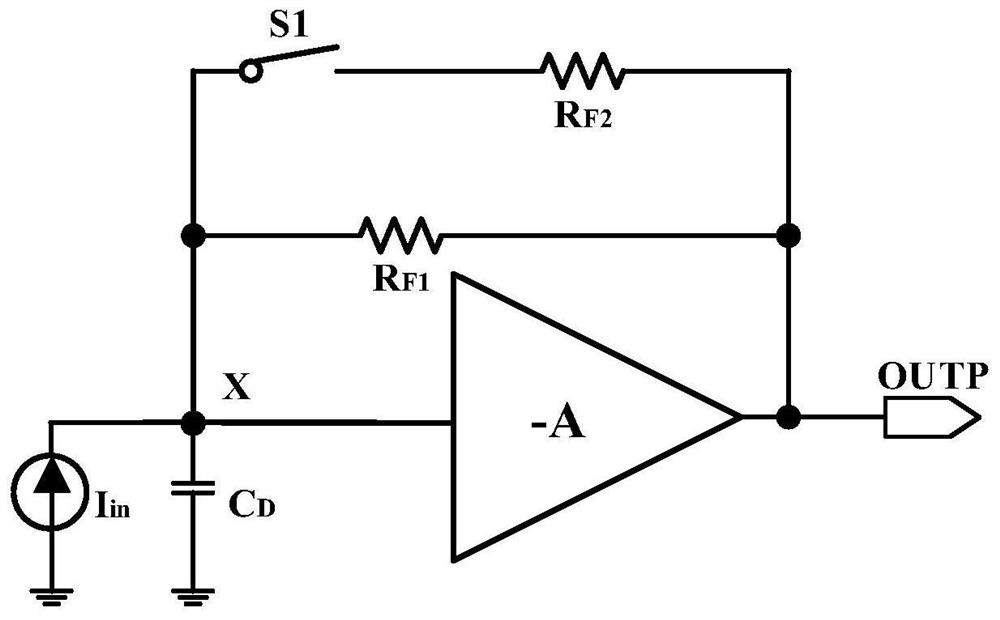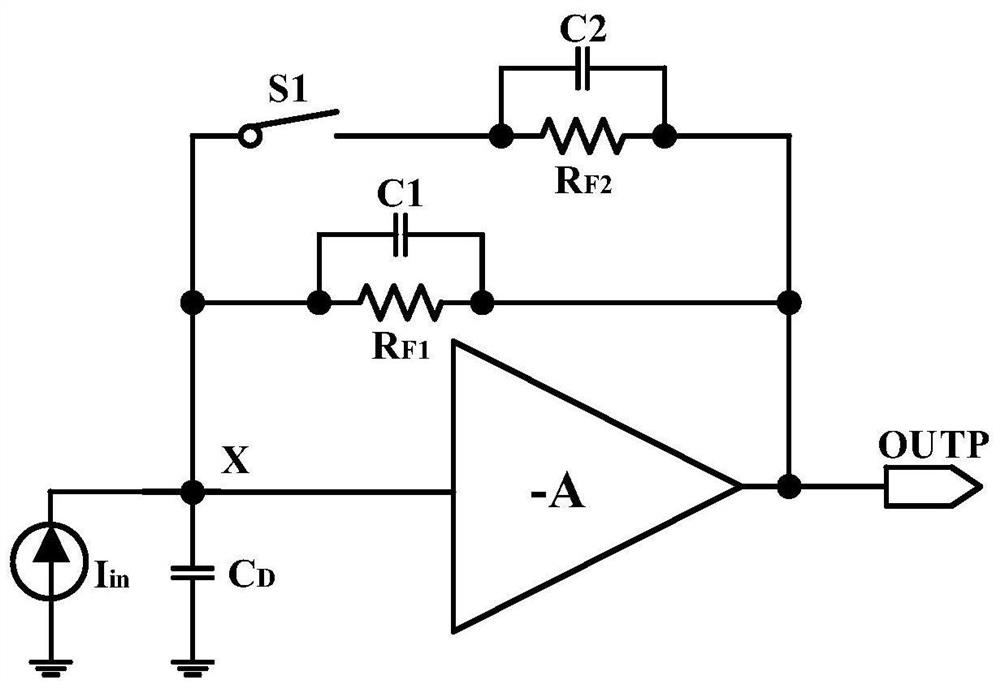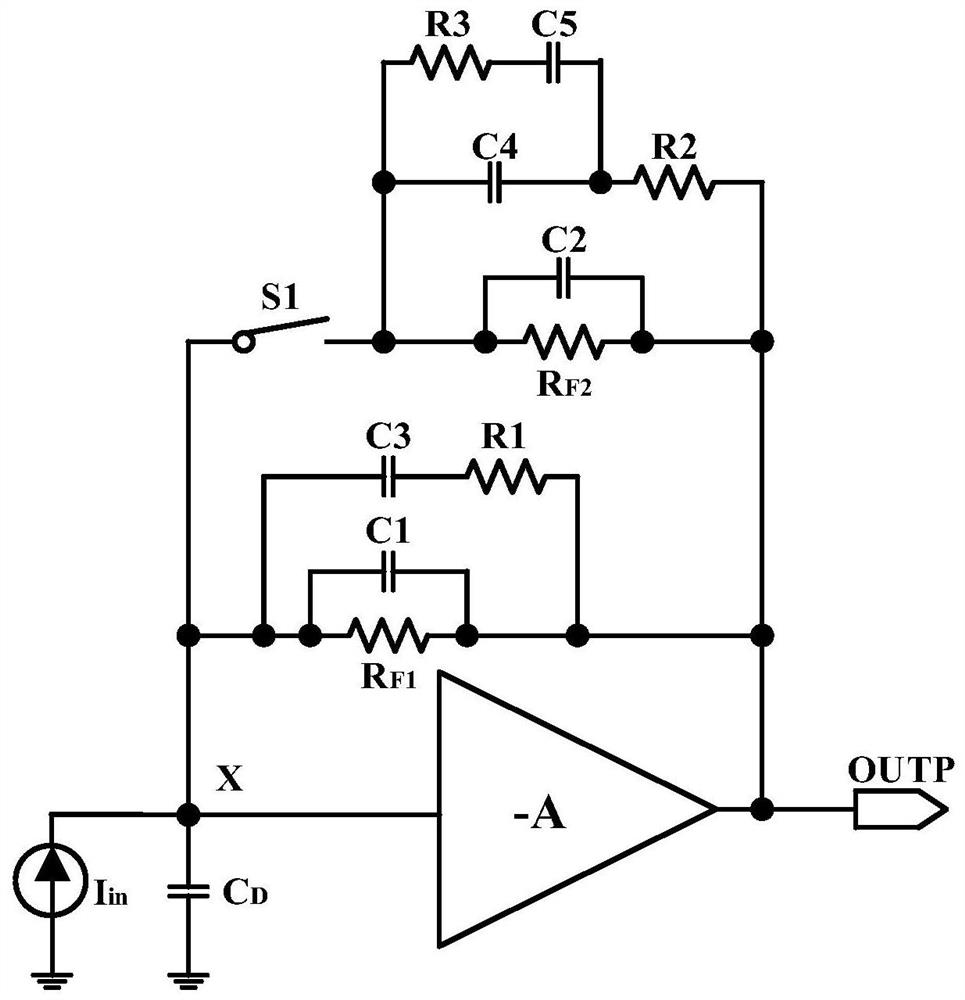Multi-transimpedance constant-bandwidth ultralow-noise TIA
A constant bandwidth, ultra-low noise technology, applied in the direction of improving amplifiers to reduce noise effects, etc., can solve problems such as the inability to guarantee the overall performance of TIA, the large variation of optional transimpedance TIA bandwidth and noise, affecting the linearity of the sensitivity output signal, etc. Achieve the effect of ensuring sensitivity and linearity, increasing dynamic range, and meeting performance requirements
- Summary
- Abstract
- Description
- Claims
- Application Information
AI Technical Summary
Problems solved by technology
Method used
Image
Examples
specific Embodiment approach 1
[0036] Specific implementation mode one: the following combination figure 2 Describe this embodiment, the multi-transimpedance constant bandwidth ultra-low noise TIA described in this embodiment, in figure 1 The conventional multi-transimpedance TIA shown is improved on the basis of the transimpedance R F1 Capacitor C1 is connected in parallel at both ends, and the transimpedance R F2 Capacitor C2 is connected in parallel at both ends, and the sizes of capacitors C1 and C2 are adjusted to keep the TIA bandwidth constant before and after switch S1 is closed.
[0037] In the description of the commonly used multi-transimpedance TIA circuit, the switch S1 is used to control the internal transimpedance resistance of the TIA to expand the dynamic range of the TIA. However, after analysis, this approach will cause a sudden change in the bandwidth of the TIA after switching the transimpedance, as well as fluctuations in the equivalent input noise. When it amplifies the input signa...
specific Embodiment approach 2
[0053] Specific implementation mode two: the following combination image 3 , Figure 5 and Figure 6 Describe this embodiment. The difference between this embodiment and Embodiment 1 is that in the transimpedance R F1 The two ends are further connected in parallel circuit structure: the resistor R3 and the capacitor C5 are connected in parallel at both ends of the capacitor C4 in series, and then connected in series with the resistor R2 and then connected in parallel at the trans-resistance R F1 both ends;
[0054] in transimpedance R F2 Further parallel circuit structure at both ends: Capacitor C3 and resistor R1 are connected in parallel in transresistance R F2 both ends;
[0055] The TIA bandwidth is constant before and after the switch S1 is closed by adjusting the size of the capacitors C1-C5.
[0056] ① When switch S1 is off:
[0057]
[0058] ②When switch S1 is closed:
[0059]
[0060] The design concept of the transfer function of this embodiment is con...
specific Embodiment approach 3
[0064] Specific implementation mode three: the following combination Figure 4 Describe this embodiment. The difference between this embodiment and Embodiment 1 or 2 is that it also includes a frequency compensation structure, which includes PMOS transistors MP1-MP4, NMOS transistors MN1-MN3, resistors R4-R5 and capacitors C6~C7;
[0065] The gate of the PMOS transistor MP3 and the gate of the PMOS transistor MP4 are simultaneously connected to the bias voltage input terminal VB, and the source of the PMOS transistor MP3 and the source of the PMOS transistor MP4 are simultaneously connected to the power supply VCC;
[0066] The gate of the PMOS transistor MP1 is connected to the signal input terminal VN, the source of the PMOS transistor MP1 and the source of the PMOS transistor MP2 are simultaneously connected to the drain of the PMOS transistor MP3; the drain of the PMOS transistor MP1 is simultaneously connected to the drain and gate of the NMOS transistor MN1 electrode an...
PUM
 Login to View More
Login to View More Abstract
Description
Claims
Application Information
 Login to View More
Login to View More - R&D
- Intellectual Property
- Life Sciences
- Materials
- Tech Scout
- Unparalleled Data Quality
- Higher Quality Content
- 60% Fewer Hallucinations
Browse by: Latest US Patents, China's latest patents, Technical Efficacy Thesaurus, Application Domain, Technology Topic, Popular Technical Reports.
© 2025 PatSnap. All rights reserved.Legal|Privacy policy|Modern Slavery Act Transparency Statement|Sitemap|About US| Contact US: help@patsnap.com



